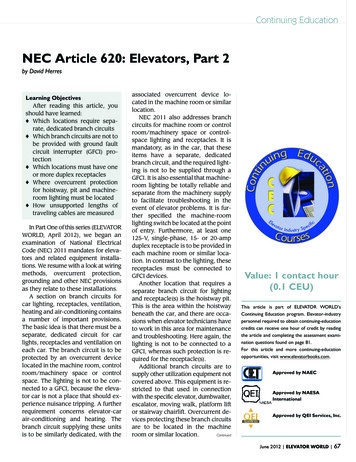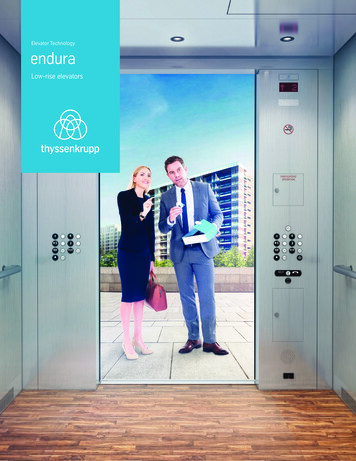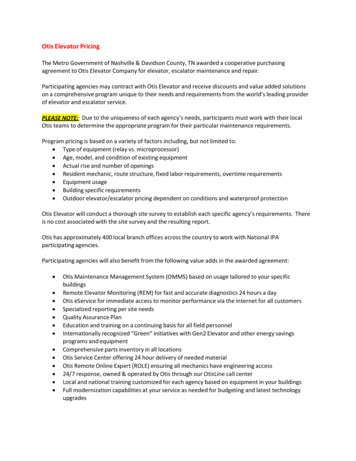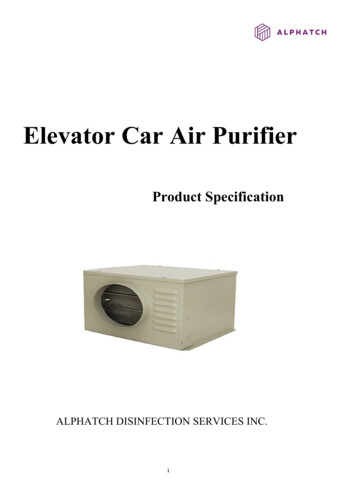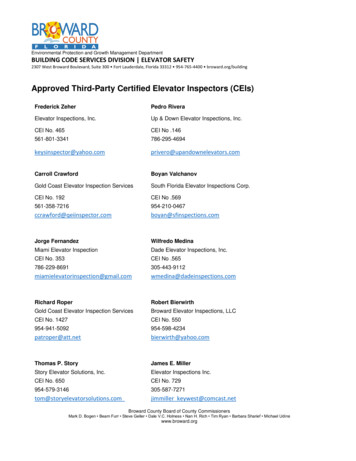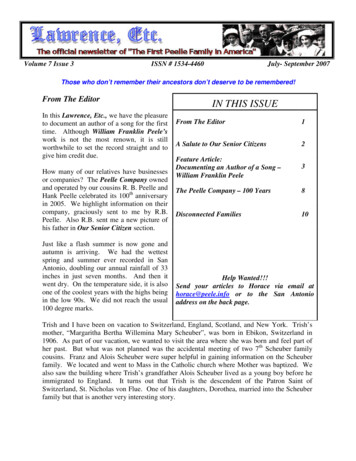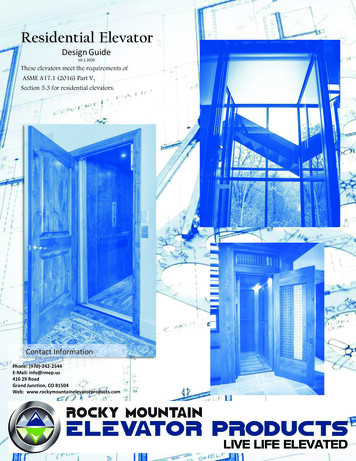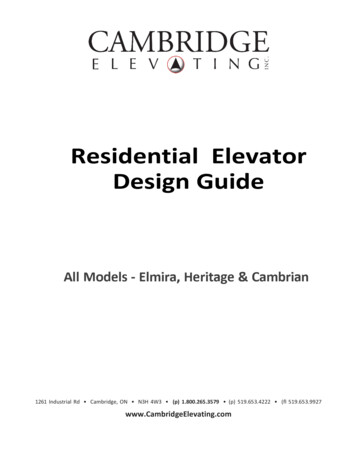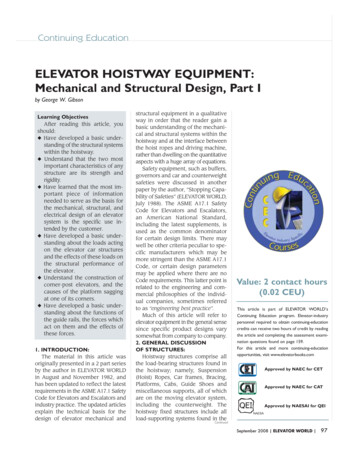
Transcription
Continuing EducationELEVATOR HOISTWAY EQUIPMENT:Mechanical and Structural Design, Part Iby George W. GibsonLearning ObjectivesAfter reading this article, youshould: Have developed a basic understanding of the structural systemswithin the hoistway. Understand that the two mostimportant characteristics of anystructure are its strength andrigidity. Have learned that the most important piece of informationneeded to serve as the basis forthe mechanical, structural, andelectrical design of an elevatorsystem is the specific use intended by the customer. Have developed a basic understanding about the loads actingon the elevator car structuresand the effects of these loads onthe structural performance ofthe elevator. Understand the construction ofcorner-post elevators, and thecauses of the platform saggingat one of its corners. Have developed a basic understanding about the functions ofthe guide rails, the forces whichact on them and the effects ofthese forces.structural equipment in a qualitativeway in order that the reader gain abasic understanding of the mechanical and structural systems within thehoistway and at the interface betweenthe hoist ropes and driving machine,rather than dwelling on the quantitativeaspects with a huge array of equations.Safety equipment, such as buffers,governors and car and counterweightsafeties were discussed in anotherpaper by the author, “Stopping Capability of Safeties” (ELEVATOR WORLD,July 1988). The ASME A17.1 SafetyCode for Elevators and Escalators,an American National Standard,including the latest supplements, isused as the common denominatorfor certain design limits. There maywell be other criteria peculiar to specific manufacturers which may bemore stringent than the ASME A17.1Code, or certain design parametersmay be applied where there are noCode requirements. This latter point isrelated to the engineering and commercial philosophies of the individual companies, sometimes referredto as “engineering best practice”.Much of this article will refer toelevator equipment in the general sensesince specific product designs varysomewhat from company to company.1. INTRODUCTION:2. GENERAL DISCUSSIONOF STRUCTURES:The material in this article wasoriginally presented in a 2 part seriesby the author in ELEVATOR WORLDin August and November 1982, andhas been updated to reflect the latestrequirements in the ASME A17.1 SafetyCode for Elevators and Escalators andindustry practice. The updated articlesexplain the technical basis for thedesign of elevator mechanical andHoistway structures comprise allthe load-bearing structures found inthe hoistway; namely, Suspension(Hoist) Ropes, Car frames, Bracing,Platforms, Cabs, Guide Shoes andmiscellaneous supports, all of whichare on the moving elevator system,including the counterweight. Thehoistway fixed structures include allload-supporting systems found in theValue: 2 contact hours(0.02 CEU)This article is part of ELEVATOR WORLD’sContinuing Education program. Elevator-industrypersonnel required to obtain continuing-educationcredits can receive two hours of credit by readingthe article and completing the assessment examination questions found on page 159.For this article and more continuing-educationopportunities, visit www.elevatorbooks.comNATIONAL ASSOCIATIONOF ELEVATOR CONTRACTORS Approved by NAEC for CETCERTIFIEDELEVATOR TECHNICIANEDUCATION PROGRAMApproved by NAEC for CATApproved by NAESAI for QEIContinuedSeptember 2008 ELEVATOR WORLD 97
Continuing EducationContinuedhoistway, such as, overhead beams, guide rails andbrackets, and pit steel.By way of introduction, a brief explanation of some of thebasic concepts of structures is in order.First of all, the basic function of any structure, be it asimple beam or complex structural frame, is to supportthe loads imposed on it. Every object on earth is subjectto the force of gravity and it is this force which producesthe load, or force, acting on the supporting structure.Throughout this article, the terms “loads” and “forces”are used freely. It should be understood that these termsare relatively synonymous in the Imperial System ofmeasurements, where the dimensional units are in lbs,kips, etc. In the Metric (SI Units) System, the loads, whichderive from the physicality of the objects, are usually referred to as Masses, expressed as kg. This article willfocus on the Imperial System.A basic law applying to structures is Newton’s ThirdLaw which states that, “for every action, there is a reaction.” The “action” is the force, or load; the “reaction” isthe effect that the supports exert on the beam or frame.Since every structure is made from materials that possess elastic properties, the structure will undergo deformations due to the loads imposed upon it. In the case ofthe simple beam with a single concentrated load, P, acting at midspan, as shown in Figure 1, the “action” is theload, P. The “reactions” are P/2 at each support. The solidline represents the position of the beam in its originallyunloaded position. The dashed line represents the deflected mode of the beam due to the load, P.In order to determine the strength of the beam andhow much it deflects, we must know the Bending Moments in the beam. Simply stated, a Bending Moment, M,is the product of a force times a distance. In the case ofthe simple beam shown in Figure 1, the maximum bending moment, M, exerted on the beam is equal to the reaction, P/2, times the distance to the load, L/2, whichequals PL/4. This is seen as follows: P L PLM 4 2 2 Due to this bending moment, the upper face of the beamtends to shorten or compress, and the lower face stretches,or elongates. In this process, internal stresses are set upin the beam. In Figure 2 the beam is shown so that its depthof section is seen as well as the shortening and elongatingof beam faces.Figure 198 WWW.ELEVATOR-WORLD.COM September 2008Figure 2The stresses set up in the beam are a measure of thisshortening and stretching of the beam’s fibers, and it is thiscriteria which we use to evaluate the strength of the beam.All structural materials have what is called an “Ultimate Strength.” This is the value of the stress when thestructural material will fail, ignoring the Theory of Plasticity. When we design our structures, we limit the allowable stress to a value far lower than the ultimate strengthof the material. The ratio of the Ultimate Stress to the Allowable Design Stress is called the Factor of Safety. Thisterm is defined in the ASME A17.1 Code. This factor ofsafety is generally arrived at by considering the use towhich the structure is put, whether human life is involved, manufacturing and fabrication errors, tolerances,etc., and is usually spelled out in local building and elevator codes. All of the structures used in the elevator system must conform to the requirements of the ASME A17.1Safety Code for Elevators and Escalators, latest edition.In addition to the strength requirements of the structural member, there is the requirement of rigidity. Asnoted in Figure 1, the beam deflects under the action ofthe load and we must set some limits on this deflection;otherwise while the beam must be strong enough to resist the load, it might, on the other hand, be too flexibleand act like a spring.Many of the structures encountered in our elevatorsystem cannot be treated in the simplest form of a beam,however. In these instances, the member may be part ofa frame. A frame, by definition, consists of a few, ormany, structural members rigidly connected to eachother at joints. In order that the subsequent discussion ofcar frames be readily understood, a few basic conceptsabout Frames will be presented here.Consider the very simple case of a 3-member structural frame, as shown in Figure 3, consisting of two vertical columns anchored to the ground at their lower endand connected to a horizontal beam resting on top ofthem, and rigidly connected at the joints. As we did before with the simple beam, let us put a load, P, on the center of the horizontal beam.As noted above, we are dealing with elastic members,and consequently, under the action of the load, the crossbeam will deflect, as noted in Figure 3.
Figure 3Figure 4Figure 5In order that the frame be stable and not collapse, thejoints must be rigid; which means that whatever angleexists between frame members before loading, must alsoexist after loading. From Figure 3, it can be seen that asthe cross beam deflected, it also underwent some rotation at its ends. Therefore, in order that the same anglebetween the column and beam remain at right angles(90 ), as in this case, the upper ends of the columns mustalso rotate the same amount as the beam. This final deflected mode for the frame is shown in Figure 4.This induced rotation at the joints causes a bendingmoment to be set up in the columns. Not only must thecolumns be designed to withstand this bending moment,but also the joint connection, whether it is welded orbolted, must be strong enough to resist the bending moment induced at the joints.This is called a Continuity Condition of Structures, andexists only when the joints are rigid. This joint rigidity isusually accomplished by putting a gusset plate at the jointand fastening it securely to adjacent members by meansof bolts, rivets or welds, or any combination. Figure 5shows such a detail.3. ELEVATOR LOADING CONDITIONS:3.1 Elevator Usage:When a customer buys an elevator, he/she will have aspecific use intended. This use is the most importantpiece of information about the elevator installation, andit will serve as a basis for the designs; mechanically,structurally and electrically.The most important single factor which influences thedesign of the car frame, platform and guide rail is themethod of transfer and distribution of loads on the elevator.Elevator use or Class of Service, as specified in ASMEA17.1 Rule 2.16.2.2, may be broken down as follows:A. Passenger Service – wherein the elevator is used primarily to carry people.B. Regular Freight Service – covers elevators loaded withsmall packages, cartons, etc.; however, no singlepiece of freight can weigh more than 25% of the ratedload. The term, Rated Load, is defined in the ASMEA17.1 Elevator Safety Code as: “The load that theequipment is designed and installed to lift at the ratedspeed”. Some manufacturers refer to this term as: DutyLoad or Contract Load.The ASME A17.1 Elevator Safety Code refers to CasesA and B, above, as Class A loading.C. Automobile Truck Service – applies to elevators thatmust carry commercial vehicles in which case nomore than 75% of the rated load, distributed betweenthe wheels on the truck, which must be at least 5 feetapart. Refer to Figure 10 for a representation of thisloading. However, the wheel load spacing is not lessthan 5 feet. This is called Class B Loading, as codifiedin ASME A17.1 Rule 2.16.2.2.2.D. Industrial Truck Service – applies to elevators that areloaded or unloaded by Industrial, or Fork Lift, Trucks,in which case approximately 80% of the rated load issupported on one axle of the truck and there is at least30” between wheels on the loaded axle. This is referred to by the ASME A17.1 Code Rule 2.16.2.2.3 asClass C Loading, and is generally the most severe typeof loading.3.2 Car Frames and Platforms – General Requirements:ASME A17.1 Rule 8.2.2.1 requires that the structuralanalysis of side-post type car frames and platforms bebased on the data and formulas given in Section 8.2.2.The basis for this requirement is that these formulascover conventional car frames and platforms. For caseswhere conventional design methodologies are not applicable, the designer can be guided by the ASME A17.1Code, which anticipates the necessity of departing fromconventional codified requirements for engineering calculations.The opening paragraph of ASME A17.1 Section 8.2states among other things: “It is not intended to limitdesign.”ASME A17.1 Rule 8.2.2.1 states in the 3rd paragraph:“For cars with corner-post, underslung, or other special car frame and platform construction, the formulasand specified methods of calculation of loads and the resulting stresses do not generally apply and shall be modified to suit the specific conditions and requirement ineach case.”While most structural designers might feel constrainedby the requirement which relates to conventional design,more imaginative structural designers can avail themselves of the broader latitude based upon the above. Utilization of contemporary structural analyses afforded byFinite Element Analysis and other modern-day methodsare made possible. However, it is important to complywith the 4th paragraph of ASME A17.1 Rule 8.2.2.1 whichstates, “The maximum allowable stresses and deflectionsof members of all car frames and platforms shall be notmore than those permitted by 2.15.10 and 2.15.11.”3.3 Load-Bearing Structures:In a completed elevator installation, the only thing visible to a casual observer is the entrance to the car and thecar interior, but the observer would certainly notice if theplatform floor on which he/she were standing sagged orContinuedSeptember 2008 ELEVATOR WORLD 99
Continuing EducationContinueddropped below the landing sill when a load was broughtonto it. The cause of the defect might be a weak carframe, or platform, insufficient guide rail supports, or acombination of any, or all, of these defects.Therefore, in the design of the structural equipment, itis a cardinal rule that, first of all, the structure is madefrom materials which have elastic properties, and secondly, due to the loads imposed on the structure, it willundergo deformations because of its elasticity. We mustbe able to predict very accurately, the effect of these deformations.The four principal load-bearing structures in a tractionelevator system are:A. Suspension (Hoist) ropes.B. The elevator platform which directly supports any loadbrought onto the elevator.C. The car frame, a rectangular structural sling lying in avertical plane to which the hoist ropes are fastened tothe upper horizontal members and the platform issupported at its center by the bottom members. In thecase of a hydraulic elevator, the plunger is generallyfastened to the underside of the plank channels, asseen in Figure 25.D. The guide rails, likened to railroad tracks, aremounted vertically in the hoistway, fastened to thebuilding structure, and are contacted by four cornerguide shoes attached to the car frame. These providestability to the elevator car in its vertical travel.4. PLATFORMS AND BRACING:The ASME A17.1 Code defines the elevator car platform as: “The structure which forms the floor of the car anddirectly supports the load”. The basic function of an elevator platform is to directly support the rated load and thecab that contains the load. Elevator platforms fall intotwo categories:A. Passenger ElevatorsB. Freight ElevatorsUntil the early 1970s, all platforms, whether passengeror freight, used wood flooring supported by a steel frame.The modern elevator platform utilizes an all-steel construction, more efficient and lighter than its woodenpredecessor.2.16.1.1 defines the minimum rated load for passenger elevators. In the mid-1970’s, a revision to the ASME A17.1Code allowed an increase in the minimum car inside areaby 5% and defined the area as being measured at a point39” above the platform floor.The general structural components in a platform assembly are:A. End channels – which are the front and rear structuralmembers of the platform which support the front ofthe car, door threshold, toe guards and the stringers.B. Stringers – are the structural members usually runningin a front-to-rear direction of the elevator and are supported by the end channels and near the center by anintermediate support.C. Floor Plate – the structural plate surface, either monolithic with the stringers, or welded to them. The finished flooring is laid on top of this plate.In the early 1970’s, the ASME A17.1 Code responded toa changing technology and introduced provisions in Rule2.15.5.4 (previously, Rule 203.5) for Laminated Platformswhich consisted of steel-faced plywood. ASME A17.1Code Rule 2.15.5.4 allows the use of Laminated Platformsfor passenger elevators having a rated load of 5000 lbs.,or less, with the requirements that the deflection at anypoint of a laminated platform, when uniformly loaded torated capacity, shall not exceed 1/960 of the span andthat the stresses in the steel facing shall not exceed 1/5of the ultimate strength. Platform frames are not requiredwith laminated platforms.A typical all-steel welded platform is shown in Figure6. The passenger platform rests on compressible blocks(usually, rubber; sometimes, elastomeric) located at 6 pointsas shown. These blocks are supported by a sub-framecalled the sound isolation support frame which, in turn, issupported by the car frame plank channels at its approximate center and by the side braces near its four corners.4.1 Passenger Platforms:Typically, within the elevator industry, passenger platforms are generally of three types; combination woodsteel design consisting of a steel frame on top of which ismounted a wooden flooring; the all-steel version whichembodies a welded structural frame to which a steel floorplate is welded forming a unitized construction; or thedesign might be comprised of several sections welded together wherein the stringers and floor plates are modules.ASME A17.1 Code Section 2.15.5 defines the requirements for the design and construction of platforms. Rule100 WWW.ELEVATOR-WORLD.COM September 2008Figure 6
As live load distributes on the platform, deflection ofthese compressible blocks occurs, thus causing measurable relative displacement between the platform and support frame. As the load increases in the car, the platformcompresses the rubber. When a predetermined compression of the rubber blocks is reached, load-weighingswitches are activated, and electrical circuits made orbroken depending upon whether you want to render thecar inoperative or bypass calls, etc. More sophisticatedsystems were introduced in the 1980s utilizing straingage technology for load measurement. These latter systems are more accurate and enable more precise loadmeasurement. Sometimes, the load cells are incorporated into the car rope hitch assembly.Sound isolation and vibration damping, introduced byOtis in 1939, are important features of modern passengerelevators. Through the use of rubber, or other compressible nonmetallic materials, all metal-to-metal contact between the elevator car and its supporting frame is eliminated. The car is permitted literally to “float” on blocks ofsoft compressible material that cushion car movement,dampen vibration, and prevent the transmission ofsound.The load-carrying capacity of the floor plate betweenthe stringers depends upon the plate thickness; the capacity of the stringers depends upon its combinedstrength with that of an effective width of floorplate.When hoistway conditions preclude the use of a onepiece platform, two-piece or multi-piece sections, boltedtogether at erection, are commonly furnished.As noted above, the stringers are supported at a minimum of three points; namely, front, center and rear.Therefore, they are designed as beams continuous overthree supports, as shown in Figure 8, and acted upon bya concentrated load at any one point. Since the stringersare spaced at certain intervals, depending upon thestrength and rigidity of the floor plate, a certain amountof the rated load can be concentrated at one point. Forregular freight loading we consider 1/4 of the rated loadacting at one point. For truck loadings, an entire wheelload may occur directly over a stringer.4.2 Freight Elevator Platforms:The construction of freight platforms consists of awelded channel frame with intermediate stringer channels welded to the outer frame. A steel floorplate is thenwelded to the stringers and frame. For purposes of designanalysis, the stringers are supported by at least threepoints; namely, the front and rear end channels (members) and at the center by the car frame planks. Depending upon the load ranges and the specific manufacturer,there may be additional intermediate supports. The platform end channels are supported by the side braces. Atypical freight platform is shown in Figure 7.Figure 8Figure 7Figure 9The end channels are treated as simple beams, supported at the ends by the side braces, under the action ofa load or loads applied at any point in accordance withthe provisions of ASME A17.1 Rule 2.16.2.2 on classes ofloading. For regular freight service (Class A loading), asan example, 1/4 of the rated load would be considered asacting at the center of the end channel as shown in Figure 9. This would produce the maximum bending moment.For Class C – Industrial Truck Loading, the beam wouldbe acted upon by two wheel loads, placed in such a mannerso as to produce maximum bending, as shown in Figure 10.Corner Post Freight Platforms are used when adjacentopenings exist. The method of construction is basicallythe same as for side post except that the frame channelusually borders the periphery of the platform. The designrequirements are somewhat different especially for truckloading elevators, since it is possible to have 2 wheelloads acting upon one stringer at the same time. ContinuedSeptember 2008 ELEVATOR WORLD 101
Continuing EducationContinued6. TRUSSES FOR CORNER POST CARS:The general arrangement for the corner post truss isshown below in Figures 12 and 13:Figure 105. BRACING FOR SIDE POST CARS:The function of the side braces is to support the corners of the platform. One end of the brace is fastened toa bracket mounted on the underside of the platform andthe other end to the car frame. Where short side bracesare used, as on passenger elevators, the upper end of thebraces are fastened to the car frame upright.The load in the side braces varies with the position ofthe live load in the car, the dead weights of the platform,enclosure, doors, and with the angle it makes with thevertical. The effect of the side brace load basically takesthree forms; namely, it induces a direct axial load alongthe longitudinal axis of the upright; due to the horizontalcomponent of the brace load, it produces bending and acorresponding deflection of the upright about its strongaxis, as seen in Figure 11; it causes the upright to twist.When side bracesare designed so thatthe centerlines of thebraces intersect theguide rail at the center of the upperguide shoes, or rollerguides, there will beno bending in the uprights caused by theforce acting on thebraces at this point.This is the main reaFigure 11son that long sidebraces are used on freight elevators since the brace load inthis case is much higher than those associated with passenger loading.The lower end of each brace is fastened directly to theplatform. At this point a bending is caused in the uprightfor the reason that the thrust from the side brace throughthe platform is at a point above the guide shoes, whichare mounted below the safety plank. But this bending,acting in the strong axis of the uprights and in close proximity to the lower guide shoes, is generally of small magnitude and not serious in most cases.102 WWW.ELEVATOR-WORLD.COM September 2008Figure 12The basic design of the truss embodies two structuralmembers, usually channels bent as required and carryinga tension rod at eachend for supporting theoutboard corners of theplatform. Occasionallywhen the brace rod loadsare very high and thecrosshead channels haveinsufficient stiffness, anadditional truss is placedbeneath the plank channels and the amount ofload carried by eachtruss depends on therelative stiffness of thecrosshead and planks,respectively.For rectangular shapedplatforms, the differenceFigure 13in length of the legs ofthe truss become so great that one channel will carrypractically all of the load, in which case, a different typeof truss might be advisable. Since Corner Post conditionsvary so widely, no fixed set of rules can be set up; therefore each case must be treated individually. It is important tostress the point again that the use to which the elevator willbe put is of extreme importance when designing cornerpost structures.7. CAR FRAMES:The ASME A17.1 Code has defined the following terms:Car Frame (Sling): The supporting frame to which the carplatform, upper and lower sets of guide shoes, car safety and
the hoisting ropes or hoisting-rope sheaves, or the plunger orcylinder of a direct-acting elevator, are attached. Specific typesinclude:Car Frame, Overslung. A car frame to which the hoistingrope fastenings or hoisting-rope sheaves are attached to thecrosshead or top member of the car frame.Car Frame, Sub-Post. A car frame all of whose membersare located below the car platform.Car Frame, Underslung. A car frame to which the hoistingrope fastenings or hoisting-rope sheaves are attached at or belowthe car platform.7.1 Car Frame Components:design. The primary advantage of this latter type of design isthat you can “put the metal where it does the most good.”In this way, more efficient and lightweight structures result.The general design, necessarily modified to suit thevariations in sizes, is substantially the same in all caseswhere the hoisting ropes are attached to the crosshead;therefore, the following remarks apply to all.7.2 Car Frame Loading and Effects – Traction Elevators:The forces acting on the car frame members are morecomplex than those acting on any other part of the elevator equipment due to the nature of its design and the factthat it must carry variable loads.If the loading condition, i.e., the manner in which theload enters or leaves the platform, as well as, the positionit takes while the elevator is running, is unknown, thenthe forces acting on the car frame cannot be determined.If the center of gravity of the rated (duty) load and carcoincided with the center of action of the hoist ropes,there would be mainly tension in the uprights and bendingin the crosshead and plank, but this condition cannot existwith a moving load; therefore, the car frame must be ableto resist turning moments, which produce bending in theuprights and, at times, twisting of the crosshead and plank.ContinuedFigure 14The car frame is a rigid rectangular frame consisting ofa crosshead, uprights and plank, as shown in Figure 14.A. Crosshead usually consists of a pair of structuralmembers, generally channel shaped, which form thetop of the car frame.B. Uprights, also called Stiles, are the vertical structuralmembers at the sides of the car.C. Plank is the structural member (or pair of members)similar to the crosshead, forming the bottom of the carframe.D. Guide Shoes are mounted on the 4 corners of the carframe and serve as the point of riding contact betweenthe car frame and guide rails.E. Car Safety is the device mounted beneath or withinthe planks, which retards and stops the car in case ofan overspeed.F. Car Frame Hitch is the pick-up point on the crossheadwhere the hoist ropes are fastened.G. Bracing Members, although not part of the car frameproper, support the corners of the platform and are, inturn, fastened to the car frame.Except for very large load capacities, the car framemembers have historically been rolled structural steelchannel sections as produced by the steel mills; however,in recent years, the elevator industry has seen the introduction of car frame members using formed or bent-upSeptember 2008 ELEVATOR WORLD 103
Continuing EducationContinuedSince we are dealing with loads that move about whileentering or leaving the platform, the exact position of theload at any given time is really unknown, so we mustmake certain assumptions regarding the positions a loadtakes while the elevator is being loaded and while it isrunning. We do know, for instance, the clear openingwidth at the entrance and that any load passing throughthis point cannot be more eccentric from the center of thecar than the entrance size will permit. On the inside ofthe car, the load can be no more eccentric than its physical size next to the cab wall will permit. Therefore, wehave a starting point for designing the car frame. Figure14 shows the specified loading eccentricities specified byASME A17.1 Figure 8.2.2.5.1 as a function of the Classesof Loading, also shown in Figure 15.The guide shoes contacting the guide rails resist thisoverturning moment and in doing so, guide shoe forcesare impressed upon the shoes and rails. It is these guideshoe forces which produce bending of the uprights. As aresult, the uprights deflect and cause the platform to sagon one side. A typical example of this is shown in Figure 16.Figure 16Figure 15In determining the required sizes of the car framemembers, the crosshead and plank seldom present difficulties, as the calculations are in most cases simple. Withthe uprights, however, the case is somewhat different.Here the sections are more or less limited for the reasonthat they must occupy a minimum amount of space between the guide rail and the side of the car so as not toencroach too much on the width of the car. The result isthat the uprights become limited in strength for bendingin the plane of the car frame, and a check is thereforenecessary for special cases to make sure they are of sufficient strength and stiffness.In both cases of loading shown in Figure 15, the carframe is subjected to an overturning moment within itsown plane, the magnitude of which is equal to the loadtimes the eccentricity, i.e., to the center of the car frame.104 WWW.ELEVATOR-WORLD.COM September 2008Although side braces and trusses are necessaryadjuncts to the car frame, they are usually considered asseparate parts of the equipment, since either type of platform supports may, under certain conditions, be usedwith the same type of car frame. When taken in connection with the forces acting on the car frame, a distinctionmust be made, sinc
Mechanical and Structural Design, Part I by George W. Gibson 1. INTRODUCTION: The material in this article was originally presented in a 2 part series by the author in ELEVATOR WORLD in August and November 1982, and has been updated to reflect the latest requirements in the ASME A17.1 Safety

